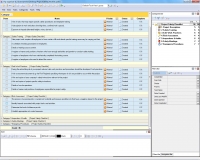|
Task Management Software |
 |
|
|
|
|
| |
|
 TESTIMONIALS TESTIMONIALS
|
|
"...This is an excellent program. I'm so glad that I stumbled on to this when researching for task management programs. Very low learning curv, quite flexible, and the price is right. Tried at least 20 other programs, either too complicated, too expensive, or poor documentation..."
Chad Lindsey -
Honolulu, HI
|
|
|
|
|
|
|
|
Project Safety Checklist |
|
|
|
|
|
|

 |
Every organization is obligated to provide a safe working environment for its employees during the source of a project. If you are going to run a new project you need first to establish safety procedures. In this Project Safety Checklist you will read how to plan for project safety and what aspects should be considered.
|
| Order 750 checklists in MS Word and PDF printable format at $49.99 USD only. |
BUY NOW!  |
1. Project Description.
- Before you can start your new project you need to make a brief description of the scope of work associated with this project. Such a description will be an overview of the type of work to be accomplished and under what conditions. Below you can find major details to be included in your project description.
- A summary of key activities and types of work to be carried out throughout the project.
- A list of tasks that may require specific safety procedures and employee training.
- A description of work restrictions (working times, confined work spaces).
- Exposure to hazards (elevated heights, noise, dust etc.).
2. Safety Training.
- Safe project work requires all employees to have certain skills and attend specific training necessary for carrying out their work in a safe manner. A safety training programme should be developed to ensure that employees are appropriately skilled and have necessary knowledge. The following information should be provided in such a programme.
- A schedule of training procedures for employees.
- Details of training course content.
- A register of names and positions of trainers who have enough authorities and permits to conduct safety training.
- A register of employees who have satisfactorily completed the training course.
- A register of employees who need to attend the course.
3. Safe Work Practices.
- During the entire lifecycle of your project relevant safe work practices and procedures should be developed. Such practices and procedures can be identified when undertaking the risk assessment process. The following below information is required for developing safe work practices and procedures for the project.
- A risk assessment document (e.g. the Risk Register) specifying what types of risk are possible to occur within the project.
- A list and copies of your company’s safety instructions relevant to the project.
- A list and copies of project-specific safety instructions.
- Details of on-site operations.
- Details of names and positions of employees responsible for project safety.
4. Risk Assessment.
- The process of assessing risks is carried out to identify and measure possible risks that have a negative impact to the project and may reduce the safety level. You can take three steps of the process to assess risks.
- Identify hazards associated with project tasks and activities.
- Determine the level of influence per risk.
- Establish appropriate risk control measures.
5. Inspections & Audits.
- Continuous inspections should be conducted to ensure that applicable safety requirements and standards are followed by every project participant. For any hazard detected during such inspections an appropriate solution should be developed, and no worker is permitted to work until the hazard is settled and safe work environment is provided. Consider the following below information when planning for safety inspections.
- Safety audit checklists.
- Frequency of inspections.
- People involved in conducting inspections and audits.
- Rules of reporting on inspection findings.
- Hazard report forms.
6. Safety Meetings.
- Pre-Project Safety Meeting. Before your project is started the project manager needs to conduct a meeting and every stakeholder should attend it. During such a meeting specific safety concerns will be reviewed. Attendees will be familiar with basic safety requirements and standards defined in the safety plan. Also aspects of project safety orientation will be outlined.
- Weekly Safety Meetings. Such meetings are planned and conducted by the project manager in cooperation with the safety coordinator. A safety meeting must address at least the following items:
- A review of accidents since the previous meeting
- A discussion on results of safety inspection
- Specific safety concerns between team members
- Unique or unusual hazards and ways to control them.
- A discussion of future work and anticipated exposures.
7. Emergency Procedures.
- There is a probability for a range of emergency situations to happen both on-site ...
| Order 750 checklists in MS Word and PDF printable format at $49.99 USD only. |
BUY NOW!  |
|





 |
CentriQS Tasks Management Solution 
Looking for multi-user task management software? Try CentriQS complete task management solution for planning, tracking and reporting tasks, projects, and schedules. Increase productivity of your small business or office by better organizing your employees' tasks and time.
 FREE Download CentriQS FREE Download CentriQS
|
|
|
|
|
|
|
|
|
|
CentriQS  -15% OFF -15% OFF |
All-in-one business management software
for small and midsize enterprises |
 |
|
|
| VIP Task Manager |
Multi-user project management software
to plan, schedule and track project tasks. |
 |
|
|
| VIP Checklists
|
More than 750 ready-to-use to-do lists
to plan your personal and business life |
 |
|
|
| VIP Team To Do List |
Professional task management software
to make and send team todo lists by email |
 |
|
|
| VIP Organizer |
Personal time management software
to organize time at home and at work |
 |
|
|
| VIP Simple To Do List
|
Simple and effective to-do list software
to plan daily chores, trips, wedding, etc. |
 |
|
|
|
|
|
|
|